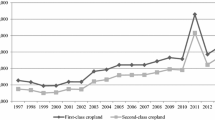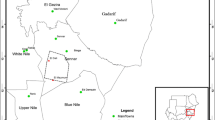Abstract
For the past decade, Thailand pursued a strategy of promoting biofuel crop production, including sugarcane, to meet the ever increasing energy demand and to increase the income of farmers. This study analyzed the influence of policy instruments implemented to promote the sugarcane cultivation, farm household socioeconomic levels, biophysical, and institutional factors driving the conversion of rice fields into sugarcane farms. Primary information was collected from 230 farm households through a structured questionnaire. Relevant policy documents published by the responsible government agencies were the main sources of secondary information collected for policy analysis. The analyses revealed that farmers in the study area converted 25–75% of their rice fields into sugarcane farms as a result of implementation of policy instruments that made sugarcane financially far more attractive than rice. The results of the regression analysis showed that eight variables were found significant and positively influenced the conversion of rice fields into sugarcane farms. These were access to extension services, information, sugarcane loading stations, and ground water for irrigation, and duration of experience in sugarcane farming as well as household head’s age and education. Irrespective of landholding size, the majority of farmers were not concerned about food security. In view of the finding, if feasible, in the form of additional price supports and commercial cane sugar index-based pricing strategies to promote sugarcane production should benefit all concerned farmers. Likewise, attention should be paid to deliver essential extension and marketing services in an effective way, particularly to those farmers who are not receiving such services.

Similar content being viewed by others
References
Adegbola P, Gardebroek C (2007) The effect of information sources on technology adoption and modification decisions. Agric Econ 37(1):55–65. doi:10.1111/j.1574-0862.2007.00222.x
Babalola DA, Okoruwa VO, Omonona BT, Oni OA (2013) Assessment of the influence of government intervention programme on sugarcane production in Nigeria: evidence from Jigawa State. J Res Dev 1(1):1–13
Basinger M, Chen J, Jeffrey-Coker F, Rodriguez-Sanchez FS, Singer T, Modi V (2012) Jatropha adoption: a statistical observational study of factors influencing Malian farmers’ decision to grow Jatropha. Agrofor Syst 84:59–72. doi:10.1007/s10457-011-9426-z
BOI (2012) Alternative energy in Thailand. Thailand Board of Investment, Ministry of Industry, Bangkok, Thailand, http://www.thinkasiainvestthailand.com/download/alternative%20energy.pdf Accessed 25 Oct 2015
BTEI (2016) Consumer price index for rural area in Thailand from 2010 until 2016. Bureau of Trade and Economic Indices, Bangkok, Thailand, http://www.price.moc.go.th/price_e/ Accessed 20 Apr 2016
Caldas MM, Bergtold JS, Peterson JM, Graves RW, Earnhart D, Gong S, Lauer B, Brown JC (2014) Factors affecting farmers’ willingness to grow alternative biofuel feedstocks across Kansas. Biomass and Bioenergy 66:223–231. doi:10.1016/j.biombioe.2014.04.009
Cheteni P, Mushunje A, Taruvinga A (2014) Barriers and incentives to potential adoption of biofuels crops by smallholder farmers in the Eastern Cape Province, South Africa. Environ Econ 5(3):71–78
Chongela J (2015) Economic analysis of outgrowers’ sugarcane and paddy production scheme at ruembe sugarcane basin in Kilosa District, Morogoro, Tanzania. Asian J Agri Extension, Econ Sociol 5(2):108–116. doi:10.9734/AJAEES/2015/14190
Cochran WG (1977) Sampling techniques, 3rd edition. Wiley, New York, NY
Coelho ST, Guardabassi P (2014) Brazil: ethanol. In: Solomon BD, Bailis R (ed) Sustainable development of biofuels in Latin America and the Caribbean. Springer, New York, NY, pp 71–101. doi:10.1007/978-1-4614-9275-7_3
DEDE (2009) Efficiency improvement for ethanol distribution, gasohol blending and distribution. Department of Alternative Energy Development and Efficiency, Ministry of Energy, Thailand, http://www.dede.go.th/article_attach/improve_co_gasohol2.pdf Accessed 31 Oct 2015
DEDE (2012) Alternative Energy Development Plan: AEDP 2012–2021. Department of Alternative Energy Development and Efficiency, Bangkok, Thailand, http://www.sert.nu.ac.th/IIRE/FP_V7N1(1).pdf Accessed 25 Jul 2015
Diop D, Blanco M, Flammini A, Schlaifer M, Kropiwnicka MA, Mautner Markhof M (2013) Assessing the impact of biofuels production on developing countries from the point of view of policy coherence for development. European Comission. Final Report (February). https://ec.europa.eu/europeaid/assessing-impact-biofuels-production-developing-countries-point-view-policy-coherence-development_en. Accessed 15 May 2016
DOAE (2014) The data on basic agricultural structure of Nong Bua Lamphu in 2014. Department of Agricultural Extension, the Ministry of Agriculture and Cooperatives, Bangkok, Thailand, (In Thai)
Ekasingh B, Sungkapitux C, Kitchaicharoen J, Suebpongsang P (2007) Competitive commercial agriculture in the Northeast of Thailand. Background paper for the Competitive Commercial Agriculture in Sub-Saharan Africa (CCAA) Study. World Bank, Washington DC, http://siteresources.worldbank.org/INTAFRICA/Resources/257994-1215457178567/CCAA_Thailand.pdf Accessed 30 Jul 2015
FAO (2009) Case studies on bioenergy policy and law: options for sustainability. Food and Agriculture Organization of the United Nations, Rome, Italy, http://www.fao.org/docrep/012/i1285e/i1285e00.htm Accessed 25 Jun 2015
Ferreira Filho JBDS, Horridge M (2014) Ethanol expansion and indirect land use change in Brazil. Land Use Policy 36:595–604. doi:10.1016/j.landusepol.2013.10.015
Gao F, Zhao L, Wang X (2010) The research review about the effect of bio-fuel development on agricultural market and agriculture. Agric Agric Sci Procedia 1:488–494. doi:10.1016/j.aaspro.2010.09.062
Gheewala SH, Damen B, Shi X (2013) Biofuels: economic, environmental and social benefits and costs for developing countries in Asia. WIREs Climate Change 4(6):497–511
Joshi NP, Maharjan KL (2007) Assessment of food self-sufficiency and food security situation in Nepal. J Int Dev Coop 13(1):209–230
Kilpatrick S (2000) Education and training: impacts on farm management practice. J Agr Educ Ext 7(2):105–116. doi:10.1080/13892240008438811
Koizumi T (2013) Biofuel and food security in China and Japan. Renew Sustain Energy Rev 21:102–109. doi:10.1016/j.rser.2012.12.047
Kongboon R, Sampattagul S (2012) Water footprint of bioethanol production from sugarcane in Thailand. J Environ Earth Sci 2(11):61–67
Kumar S, Abdul Salam P, Shrestha P, Ackom EK (2013) An assessment of Thailand’s biofuel development. Sustain 5(4):1577–1597. doi:10.3390/su5041577
Mabiso A (2012). Participation of smallholder farmers in biofuels crop and land rental markets: evidence from South Africa. In Selected Paper prepared for presentation at the International Association of Agricultural Economists (IAAE) Triennial Conference; 2012 Aug 18–24; Foz do Iguacu, Brazil. http://purl.umn.edu/126370. Accessed 15 May 2016
Mapemba LD, Grevulo JA, Mulagha AM (2013) What drives adoption of biofuel (Jatropha Curcas) production in central eastern Malawi? J Energy Technol Policy 3(10):75–92
Masuku MB, Dlamini MB (2012) Profitability of smallholder sugarcane farming in Swaziland: the case of komati downstream development programme (KDDP) sugar farmers’ associations, 2005-2011. Sustain Agric Res 2(4):1–7. doi:10.5539/sar.v2n1p8
MOAC (2010) Good agricultural practices for sugarcane. National Bureau of Agricultural Commodity and Food Standards, Ministry of Agricultural and Cooperatives, Bangkok, Thailand, http://www.acfs.go.th/standard/download/eng/GAP_sugarcane.pdf Accessed 18 Aug 2015
Moraes MAFDD, Zilberman D (2014) Production of Ethanol from Sugarcane in Brazil. Springer, New York, NY. doi:10.1007/978-3-319-03140-8
Negash M, Swinnen JFM (2013) Biofuels and food security: micro-evidence from Ethiopia. Energy Policy 61:963–976. doi:10.1016/j.enpol.2013.06.031
OAE (2012) Agricultural Statistics of Thailand 2012. Office of Agricultural Economics. Ministry of Agriculture and Cooperatives, Bangkok, Thailand, http://www.oae.go.th/download/download_journal/yearbook55.pdf Accessed 15 Jul 2015
OAE (2014) Agricultural Statistics of Thailand 2014. Office of Agricultural Economics. Ministry of Agriculture and Cooperatives, Bangkok, Thailand, http://www.oae.go.th/download/download_journal/2558/yearbook57.pdf Accessed 15 Jul 2015
OECD-FAO (2004) Agricultural Outlook 2004. Organization for Economic Development and Cooperation (OECD), Paris; Food and Agricultural Organization of the United Nations, Rome, Italy, http://www.oecd-ilibrary.org/agriculture-and-food/oecd-fao-agricultural-outlook-2004/summary/english_agr_outlook-2004-sum-en?isSummaryOf=/content/book/agr_outlook-2004-en Accessed 9 Sep 2015
Peiris TDGJ, Abeynayake NR, Perera MS (2009) Socio-economic factors affecting the technology adoption level of sugarcane in rainfed sector in Sevenagala. J Food Agric 2(2):22–27. doi:10.4038/jfa.v2i2.4177
Popp J (2011) Economic balance on competition for arable land between food and biofuel: global responsibilities of food, energy and environmental security. in Challenges for Agricultural Research, OECD Publishing, Paris. doi:10.1787/9789264090101-12-en
Prasertsri P (2014) Thailand sugar annual 2014. USDA Global Agricultural Information Network Report, Bangkok, Thailand. http://www.thefarmsite.com/reports/contents/ThailandSugar22April2014.pdf. Accessed 31 Aug 2015
Preechajarn S, Prasertsri P (2012) Thailand biofuels annual 2012. USDA Global Agricultural Information Network Report, Bangkok, Thailand. http://gain.fas.usda.gov/Recent%20GAIN%20Publications/Biofuels%20Annual_Bangkok_Thailand_6-29-2012.pdf. Accessed 31 Aug 2015
Preechajarn S, Prasertsri P (2014) Thailand biofuels annual 2014. USDA Global Agricultural Information Network Report, Bangkok, Thailand. http://gain.fas.usda.gov/Recent%20GAIN%20Publications/Biofuels%20Annual_Bangkok_Thailand_6-27-2014.pdf. Accessed 31 Aug 2015
Preechajarn S, Prasertsri P (2015) Thailand biofuels annual 2015. USDA Global Agricultural Information Network Report, Bangkok, Thailand. http://gain.fas.usda.gov/Recent%20GAIN%20Publications/Biofuels%20Annual_Bangkok_Thailand_7-13-2015.pdf. Accessed 31 Oct 2015
Rasul G, Thapa GB, Zoebisch MA (2004) Determinants of land-use changes in the Chittagong Hill Tracts of Bangladesh. Appl Geogr 24(3):217–240. doi:10.1016/j.apgeog.2004.03.004
Rogers EM (2003) Diffusion of innovations, 5th edition. The Free University Press, New York, NY
Rosegrant MW, Ewing M, Msangi S, Zhu T (2008) Bioenergy and global food situation until 2020/2050. German Advisory Council on Global Change. Berlin, Germany. http://www.wbgu.de/fileadmin/templates/dateien/…/jg2008/wbgu_jg2008_ex08.pdf. Accessed 25 Jun 2015
Salvatore M, Damen B (2010) Bioenergy and the BEFS Analysis for Thailand. Food and Agriculture Organization, Rome, Italy, http://www.fao.org/energy/befs/82343/en/ Accessed 25 Jul 2015
Srijantr T, Molle F, Chompadist C (2002) Profitability and yield gap of sugar cane cultivation in the Mae Klong region. Thai Agric Econ J 18(1):53–69
Tongchure S, Hoang N (2013) Cassava smallholders’ participation in contract farming in Nakhon Ratchasrima. J Soc Dev Sci 4(7):332–338
Van Oort PAJ, Saito K, Tanaka A, Amovin-Assagba E, Van Bussel LGJ, Van Wart J et al (2014) Assessment of rice self-sufficiency in 2025 in eight African countries. Glob Food Sec 5:39–49. doi:10.1016/j.gfs.2015.01.002
World Bank (2008) World Development Report 2008. agriculture for development. World Bank, Washington D.C.
Zulfiqar F, Thapa GB (2016) Is ‘Better cotton’ better than conventional cotton in terms of input use efficiency and financial performance? Land Use Policy 52:136–143. doi:10.1016/j.landusepol.2015.12.013
Acknowledgements
The first author gratefully acknowledges the scholarship provided by the Ministry of Agriculture and Cooperatives for her PhD studies at the Asian Institute of Technology (AIT) of Thailand that made possible to carry out this study. The authors sincerely appreciate the assistance of farmers in the study area who kindly provided needed information despite their very busy work schedule. Finally, the authors would like to extend sincere thanks to three anonymous reviewers for their constructive comments on the earlier draft of the manuscript.
Author information
Authors and Affiliations
Corresponding author
Ethics declarations
Conflict of Interest
The authors declare that they have no competing interests.
Rights and permissions
About this article
Cite this article
Lakapunrat, N., Thapa, G.B. Policies, Socioeconomic, Institutional and Biophysical Factors Influencing the Change from Rice to Sugarcane in Nong Bua Lamphu Province, Thailand. Environmental Management 59, 924–938 (2017). https://doi.org/10.1007/s00267-017-0843-2
Received:
Accepted:
Published:
Issue Date:
DOI: https://doi.org/10.1007/s00267-017-0843-2




